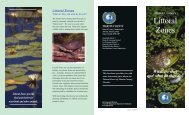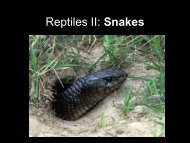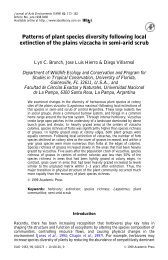BoletÃÂn Chileno de OrnitologÃÂa - Wildlife Ecology and Conservation ...
BoletÃÂn Chileno de OrnitologÃÂa - Wildlife Ecology and Conservation ...
BoletÃÂn Chileno de OrnitologÃÂa - Wildlife Ecology and Conservation ...
Create successful ePaper yourself
Turn your PDF publications into a flip-book with our unique Google optimized e-Paper software.
ARTICULOS15are all important mutualists with plants in our studyarea (Armesto et al. 1987, 1996; Smith-Ramírez1993; Willson et al. 1994, 1996b). Previous workshowed that population <strong>de</strong>nsities of all three arerelatively high in forest fragments; in<strong>de</strong>ed, E.albiceps was the most frequently <strong>de</strong>tected bird inmany study sites (Willson et al. 1994, Rozzi et al.1996). The low nest success (20-30%), togetherwith a small clutch size (usually 2 or 3 eggs),suggests that populations might have difficultymaintaining current levels (in the absence ofimmigration to fragments), <strong>and</strong> interactions withnative plants may ultimately be impaired. However,additional information on <strong>de</strong>mographic traits (e.g.,juvenile <strong>and</strong> adult survival, number of nestingattempts per year) of these birds is nee<strong>de</strong>d in or<strong>de</strong>rto assess this risk properly.It is becoming clear that general rules aboutthe effects of habitat fragment size <strong>and</strong> edge effectsare difficult to formulate. Many factors contributeto the observed variation, including l<strong>and</strong>scapecontext (<strong>de</strong>gree of fragmentation, structure of thematrix, Castellón <strong>and</strong> Sieving 2006, Tewksbury etal. 2006), regional differences in abundance,distribution, <strong>and</strong> i<strong>de</strong>ntity of predators <strong>and</strong> broodparasites, <strong>and</strong> differing responses of the nesting birdsthemselves (e.g., Friesen et al. 1999, Morse <strong>and</strong>Robinson 1999, De Santo <strong>and</strong> Willson 2001).Achievement of conservation goals for at-riskbreeding birds therefore requires knowledge of localrisk patterns <strong>and</strong> will commonly requireexamination on a case-by-case basis.ACKNOWLEDGMENTSWe thank Corporación Nacional Forestal forlogistical support, numerous field assistants for theirintensive work, <strong>and</strong> many Chilote l<strong>and</strong>owners fortheir gracious permission to work in their forests. K.Hyer <strong>and</strong> T. Max assisted with statistical analyses.Comments from C. Esta<strong>de</strong>s, E. Lance, <strong>and</strong> J.Morrison improved the manuscript. This work wassupported by National Science Foundation-International Programs (grant number 96-02917),National Geographic Society Committee for Research<strong>and</strong> Exploration (grant 5457-95), <strong>and</strong> the PacificNorthwest Research Station. Collaboration of MWF<strong>and</strong> JJA during manuscript preparation was supportedby Conicyt grant 1501-0001 to the Center forAdvanced Studies in <strong>Ecology</strong> <strong>and</strong> Biodiversity(CASEB). This manuscript is a contribution fromCASEB <strong>and</strong> the research program of EstaciónBiológica Senda Darwin in Chiloé.LITERATURE CITEDARMESTO, J. J. & J. FIGUEROA. 1987. St<strong>and</strong>structure <strong>and</strong> dynamics in the temperate rainforests of Chiloé Archipelago, Chile. Journalof Biogeography 14:367-376.ARMESTO, J. J., R. ROZZI, P. MIRANDA, & C.SABAG. 1987. Plant/frugivore interactionsin South American temperate forests. RevistaChilena <strong>de</strong> Historia Natural 60:321-326.ARMESTO, J. J., C. SMITH-RAMÍREZ, & C.SABAG. 1996. The importance of plantbirdmutualism in the temperate rainforest ofsouthern South America. Pp. 248-265 in InR.G. Lawford, P.B. Alaback, & E. Fuentes[eds.], High-latitu<strong>de</strong> rainforests <strong>and</strong>associated ecosystems of the west coast ofthe Americas: climate, hydrology, ecology,<strong>and</strong> conservation. Springer-Verlag, Berlin.ASKINS, R. A. 1995. Hostile l<strong>and</strong>scapes <strong>and</strong> the<strong>de</strong>cline of migratory songbirds. Science3267:1956-1957.BALMFORD, A. & A. LONG. 1994. Avianen<strong>de</strong>mism <strong>and</strong> forest loss. Nature 372:623-624.BÖHNING-GAESE, K., B. HALBE, N. LEMOINE,& R. OBERATH. 2000. Factors influencingthe clutch size, number of broods <strong>and</strong> annualfecundity of North American <strong>and</strong> Europeanl<strong>and</strong> birds. Evolutionary <strong>Ecology</strong> Research2: 823-839.CASTELLÓN, T. D. <strong>and</strong> K. E. SIEVING. 2006. Anexperimental test of matrix permeability <strong>and</strong>corridor use by an en<strong>de</strong>mic un<strong>de</strong>rstory bird.<strong>Conservation</strong> Biology 20: 135-145.CORNELIUS, C., H. COFRE, & P. A. MARQUET.2000. Effects of habitat fragmentation on birdspecies in a relict temperate forest in semiaridChile. <strong>Conservation</strong> Biology 14:534-543.DE SANTO, T. L. & M. F. WILLSON. 2001.Predator abundance <strong>and</strong> predation of artificialnests in natural <strong>and</strong> anthropogenicconiferous forest edges in southeast Alaska.Journal of Field Ornithology 72:136-149.


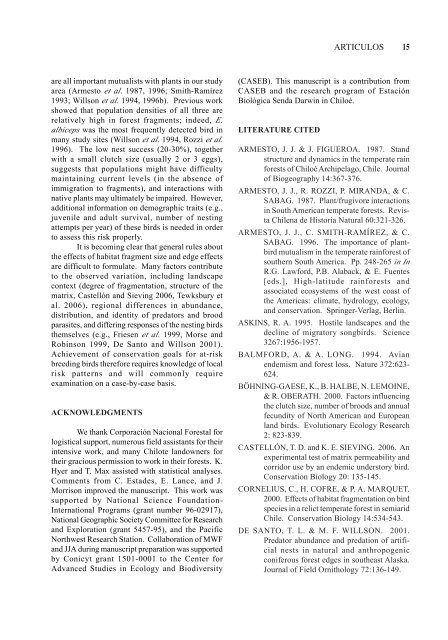
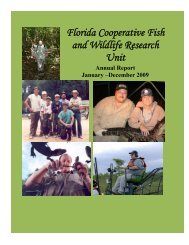
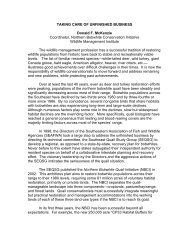
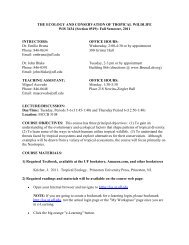
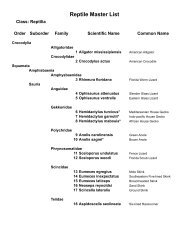

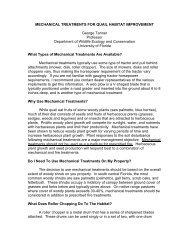
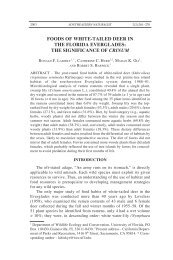
![rivers,lakes.ppt [Read-Only]](https://img.yumpu.com/43445703/1/190x245/riverslakesppt-read-only.jpg?quality=85)
